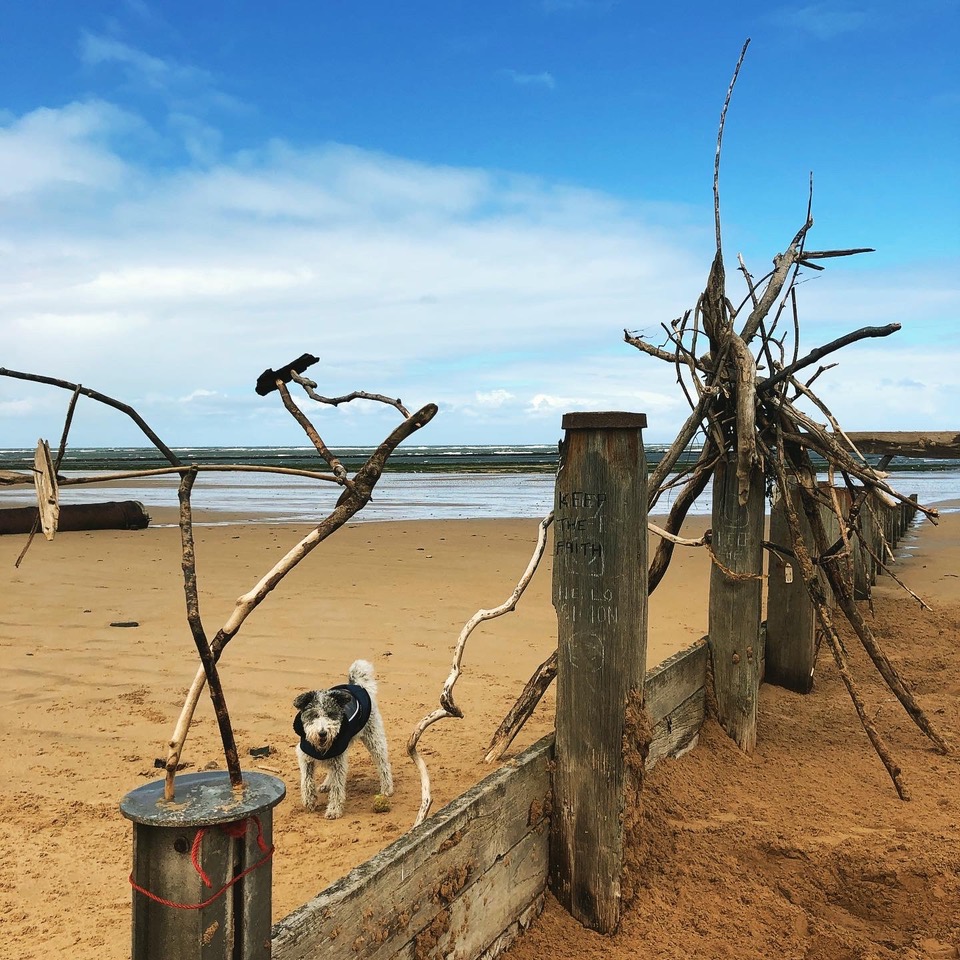Sally Rodgers evokes the coastal Teesside landscape that shaped a mix – part field recording, part Nordic folk, part nu goth – made with A Man Called Adam collaborator Steve Jones.

I grew up in Teesside and after many years away – London, Cornwall, West Yorkshire – I recently returned. The coast here is wild and bleak. The North Sea is vast and foreboding, its colours ranging from flinty blues to pewter and murky greens on stormy days. My house is maybe 500 metres from the beach and throughout lockdown me and my dog have spent many meditative hours exploring this coast – a coast I know so well but am always discovering something new about. If you look south from here the epic Jurassic coastline unfolds like a rust-coloured ribbon – Hunt Cliff, Sandsend, Staithes, Whitby. If you look north the big, dirty mouth of the river Tees is bordered by heavy industry; ICI, BOC, the coke ovens of British Steel, and offshore wind turbines that turn in their rows.
The natural world you experience here isn’t picturesque. It isn’t pretty woodland or rolling hills and dales. There are miles and miles of lime grass bordering miles and miles of beach so flat they train racehorses on it. Gulls, crows and starlings, like hooligan scavengers, crowd the seafronts looking for scraps. Rough piebald ponies graze on plots in the shadows of the now dormant steelworks.
I walk Monty on a stretch of land that borders the beach near my house, known locally as The Stray. Again it isn’t picture postcard but I see the seasons change, the grasses flowering, the weasels and stoats that build their burrows deep beneath its sandy hills. Hawks hunt them overhead and swallows nest in holes that spot the red clay of the cliff sides. There are seals sometimes, resting from a stormy sea and the local wildlife trust tell you to leave them alone unless they look distressed. Cormorants perch and dry their outstretched wings on the baskets that mark the breakers, and remind me of Gotham City’s bat signal. My dog loves to roll in anything smelly and on our walks this year we’ve ‘encountered’ a dead sunfish from some tropical sea, with its tiny mouth full of teeth; a metre-long conger eel, and a shining silver porpoise, all washed in on the sometimes raging tide. There’s always something interesting to see – sea anemones, starfish, barnacles breathing on a piece of driftwood. My favourite bits of beach flotsam are a fossilised horse mandible I found, and a fragment of glittering pink quartz.
My walks have kept me sane through all this. That sound, either calm or ferocious, of waves lapping or crashing onto the shore blots out all other mental noise. You can see the weather here too; thunderstorms falling like veils out at sea, or winds that ripple the surface of the sand into a flowing river. I never listen to music when I’m on my walks. This place has its own music and it focuses the mind. I love to walk out in a storm, to be battered by the elements. Or in the summer, take off my shoes and socks and splash along the water’s edge with Monty, the sandpipers huddling together, down the sea and back…
I have a studio in my house and Steve, who lives in Paris mostly, has been back a few times in the last year to teach and see his family, and to work with me. He knows and loves this coastline too, and after being cooped up in the city appreciates the open spaces, the bracing winds, the savage beauty of the place. There’s a little pile of stones and fossils he’s collected on a shelf in his room. He’s even downloaded an app that identifies the ships and carriers moving the goods we all take for granted in and out of Teesport. Ironopolis they used to call it.
We made some field recordings of the sea and the sounds at the South Gare where the beach meets the industry to add to this mix, and the music we’ve curated is a mixture of meditative sound art, Nordic folk, and a little bit of Northern indie. It’s a bit nu goth, we thought.
I believe that wherever you go there is much to love if you’re open to it. It might not be the unctuous, sensual beauty you find in some of Britain’s glorious national parks, but it is beautiful here. Brutal, bleak and inhabited by wonderful, resilient creatures.
*
You can follow A Man Called Adam on Bandcamp and Spotify.